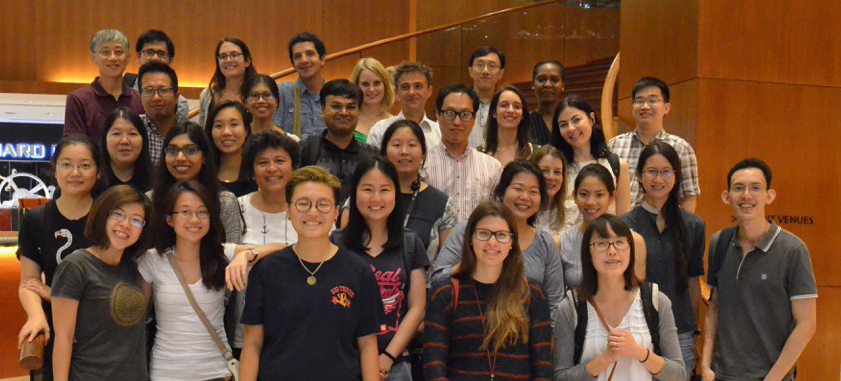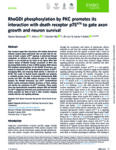October 4th, 2018 In this new paper, we have used a novel chemical biology approach to identify a small molecule targeting the transmembrane domain of death receptor p75NTR that induces melanoma cell death and reduces tumor growth
Small molecules offer powerful ways to alter protein function. However, most proteins in the human proteome lack small-molecule probes, including the large class of non-catalytic transmembrane receptors, such as death receptors. We hypothesized that small molecules targeting the interfaces between transmembrane domains (TMDs) in receptor complexes may induce conformational changes that alter receptor function. Applying this concept in a screening assay, we identified a compound targeting the TMD of death receptor p75<sup>NTR</sup> that induced profound conformational changes and receptor activity. The compound triggered apoptotic cell death dependent on p75<sup>NTR</sup> and JNK activity in neurons and melanoma cells, and inhibited tumor growth in a melanoma mouse model. Due to their small size and crucial role in receptor activation, TMDs represent attractive targets for small-molecule manipulation of receptor function.
The paper has just been published in Cell Chemical Biology.
Read the full paper HERE.
September 10th, 2018 UPDATE: The positions have been filled.
We are seeking talented and enthusiastic researchers with expertise in cell signaling, cell biology and mouse genetics to advance investigations on the functions and mechanisms of growth factor receptor signaling and physiology. The research entails studies of different receptor systems, including death receptor p75NTR, TGFbeta superfamily receptor ALK7 and neurotrophin receptor TrkB, using molecular methods, cell culture models and mutant mice carrying specific mutations in these receptors. Please refer to our recent list of publications in this areas.
Candidates will be accepted at the postdoctoral level with a PhD awarded preferably within the last 5 years. Strong and documented expertise in cellular, molecular and histological methods as applied to studies of mouse models in the areas of either neurobiology, metabolic regulation or cancer is a requirement for consideration. The successful candidate is expected to be sufficiently independent to formulate questions, design experiments and perform research.
We are recruiting fellows for our laboratories at the National University of Singapore and the Karolinska Institute in Stockholm, Sweden. Interested applicants can apply to both locations or just one. Work at the two laboratories is seamlessly integrated through joint lab meetings, common reagent and protocol records, and other cloud-based tools. Both sites provide exciting environments to pursue biomedical research at the highest level and a great opportunity to advance a career in science in exciting locations in Europe and Asia.
Applications, including CV, list of publications and statement of research interests should be sent to Prof. Carlos Ibanez ( or or  ). Applicants should arrange to have at least two confidential letters of reference sent independently by referees to either email address. ). Applicants should arrange to have at least two confidential letters of reference sent independently by referees to either email address.
Applications will be considered as they arrive until the positions are filled. Interested applicants are strongly recommended to submit their applications as soon as possible. Funding is available for an initial period of 3 to 4 years, starting any time during 2018 or early 2019.
July 24th, 2018 In this new paper, we show how intracellular effectors RIP2 and TRAF6 compete for binding to the p75NTR intracellular domain to regulate cell death of cerebellar granule neurons.
Cerebellar granule neurons (CGNs) undergo programmed cell death during the first postnatal week of mouse development, coincident with sustained expression of the death receptor p75NTR. Although ablation of p75NTR did not affect CGN cell death, deletion of the downstream effector RIP2 significantly increased CGN apoptosis, resulting in reduced adult CGN number and impaired behaviors associated with cerebellar function. Remarkably, CGN death was restored to basal levels when p75NTR is deleted in RIP2-deficient mice. We found that RIP2 gates the signaling output of p75NTR by competing with TRAF6 for binding to the receptor intracellular domain. In CGNs lacking RIP2, more TRAF6 was associated with p75NTR, leading to increased JNK-dependent apoptosis. In agreement with this, pharmacological inhibition or genetic ablation of TRAF6 restored cell death levels in CGNs lacking RIP2. These results revealed an unexpected mechanism controlling CGN number and highlight how competitive interactions govern the logic of death receptor function.
The paper has just been published in Cell Reports.
Read the full paper HERE.
May 30th, 2018 In this new paper, we show how the GDNF receptor GFRα1 functions cell-autonomously in subpopulations of olfactory bulb interneuron precursors to regulate their generation and allocation in the mammalian olfactory bulb.
GFRα1, a receptor for glial cell line-derived neurotrophic factor (GDNF), is critical for the development of the main olfactory system. The olfactory bulb (OB) of Gfra1 knockout mice showed significant reductions in the number of olfactory sensory neurons, mitral and tufted cells, as well as all major classes of OB GABAergic interneurons. However, the latter did not express significant levels of GFRα1, leaving the mechanism of action of GFRα1 in OB interneuron development unexplained. We have found that GFRα1 is highly expressed in the precursor cells that give rise to all major classes of OB interneurons, but is downregulated as these neurons mature. Conditional ablation of GFRα1 in embryonic GABAergic cells recapitulated the cell losses observed in global Gfra1 knockouts at birth. GFRα1 was also required for the sustained generation and allocation of OB interneurons in adulthood. Conditional loss of GFRα1 altered the migratory behaviour of neuroblasts along the rostral migratory stream (RMS) as well as RMS glial tunnel formation. Together, these data indicate that GFRα1 functions cell-autonomously in subpopulations of OB interneuron precursors to regulate their generation and allocation in the mammalian OB.
The paper has just been published in Biology Open.
Read the full paper HERE.
April 25th, 2018 Jason has successfully defended his thesis today titled “Understanding The Influence Of TDP-43 Loss-Of-Function On Neurotrophin Signalling”. Committee members Soong Tuck Wah, Garrie Arumugam and John Chua had a closed door session with him after the presentation, but we hear that it all went well. Congratulations to Dr. Jason!
December 10th, 2017 Presentation Speech by Professor Carlos Ibáñez, Member of the Nobel Assembly at the Karolinska Institute, Member of the Nobel Committee for Physiology or Medicine, at the award ceremony of the Nobel Prize, 10 December 2017.
August 28th, 2017 Vanessa Rodrigues holds a PhD in Pathology and Molecular Genetics from ICBAS, University of Porto, Portugal, with a thesis work entitled “Understanding P-glycoprotein mediated multidrug resistance in cancer: new potential targets, biomarkers and molecular inhibitors”. Vanessa joins the NUS group to lead a drug discovery program to identify novel chemical probes targeting p75NTR, TrkB and ALK7 receptors.
July 10th, 2017 Ajeena Ramanujan holds a PhD from the Jawaharlal Nehru University, India, for work on the interaction between FZR1 and the Retinoblastoma protein in the control of cell-cycle regulation, under the direction of A/Prof Swati Tiwari. Ajeena is joining the NUS group to lead investigations on p75NTR signaling mechanisms involving RhoGDI and RhoA proteins and their actions on the cell cytoskeleton and neurite outgrowth control.
June 14th, 2017 In this new paper, we show how the GDNF regulates survival of molecular layer interneurons in the cerebellum to control normal cerebellar motor learning. The paper has just been published in Cell Reports.
The role of neurotrophic factors as endogenous survival proteins for brain neurons remains contentious. In the cerebellum, the signals controlling survival of molecular layer interneurons (MLIs) are unknown, and direct evidence for the requirement of a full complement of MLIs for normal cerebellar function and motor learning has been lacking. Here, we show that Purkinje cells (PCs), the target of MLIs, express the neurotrophic factor GDNF during MLI development and survival of MLIs depends on GDNF receptors GFRα1 and RET. Conditional mutant mice lacking either receptor lose a quarter of their MLIs, resulting in compromised synaptic inhibition of PCs, increased PC firing frequency, and abnormal acquisition of eyeblink conditioning and vestibulo-ocular reflex performance, but not overall motor activity or coordination. These results identify an endogenous survival mechanism for MLIs and reveal the unexpected vulnerability and selective requirement of MLIs in the control of cerebellar-dependent motor learning.
Read the full paper HERE.
January 18th, 2017 Fellows from the KI lab flew to Singapore for a 2 day retreat with the NUS group on 16th and 17th of January 2017. After 4 years of joint lab meetings over Skype, fellows of both groups enjoyed an opportunity to discuss common projects and ideas face to face. We were joined by the NUS and UCSD groups of Prof. Ed Koo and had joint plenary and also parallel sessions, as well as group building activities, as shown in the photo below.

|
|
|
Warning: Undefined array key "full_width_footer" in /customers/2/6/6/carlosibanezlab.se/httpd.www/NUS/wp-content/themes/atahualpa_3723/footer.php on line 93




